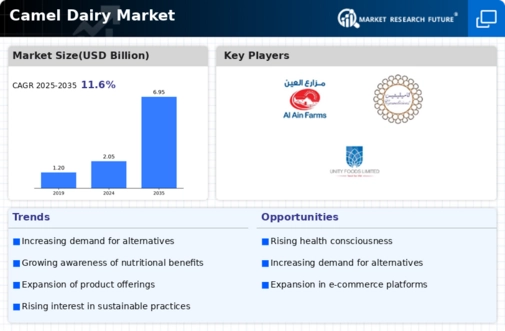Market Growth Projections
The Global Camel Dairy Market Industry is projected to experience substantial growth, with estimates indicating an increase from 2.05 USD Billion in 2024 to 6.95 USD Billion by 2035. This growth trajectory suggests a compound annual growth rate (CAGR) of 11.74% from 2025 to 2035, reflecting the increasing consumer interest in camel milk and its derivatives. The market's expansion is likely influenced by various factors, including rising health consciousness, innovative product offerings, and enhanced production capabilities. These projections underscore the potential of camel dairy to carve out a significant niche within the broader dairy market.
Growing Export Opportunities
The Global Camel Dairy Market Industry is poised to benefit from expanding export opportunities as countries recognize the value of camel milk on the international stage. Regions with established camel dairy production are increasingly targeting foreign markets, particularly in Europe and Asia, where demand for alternative dairy products is rising. This trend suggests a potential for increased revenue streams and market penetration. As the global market for camel dairy expands, the ability to export products will likely play a crucial role in driving growth and establishing camel milk as a staple in the global dairy market.
Innovative Product Development
The Global Camel Dairy Market Industry is experiencing a wave of innovative product development, with manufacturers introducing a variety of camel milk-based products. These include cheese, yogurt, and powdered milk, catering to diverse consumer preferences and dietary needs. Such innovations not only enhance the appeal of camel dairy but also broaden its market reach. As consumers increasingly seek unique and health-oriented food products, the introduction of these innovative offerings is likely to contribute to the market's growth trajectory, aligning with the overall trend of diversification in the dairy sector.
Expansion of Camel Dairy Production
The Global Camel Dairy Market Industry is witnessing an expansion in camel dairy production, particularly in arid and semi-arid regions where camels are well-adapted. Countries such as the United Arab Emirates and Saudi Arabia are investing in modernizing camel farms and enhancing production techniques. This expansion is crucial as it aligns with the increasing global demand for camel milk, which is expected to grow significantly. The industry may see production levels rise, contributing to the projected market growth from 2.05 USD Billion in 2024 to an estimated 6.95 USD Billion by 2035, indicating a robust CAGR of 11.74% for the period from 2025 to 2035.
Rising Demand for Nutritional Products
The Global Camel Dairy Market Industry experiences a notable surge in demand for nutritional products, driven by the increasing awareness of health benefits associated with camel milk. Camel milk is rich in vitamins, minerals, and proteins, making it a preferred choice among health-conscious consumers. In 2024, the market is projected to reach 2.05 USD Billion, reflecting a growing consumer base that values natural and nutritious food sources. This trend is particularly pronounced in regions where traditional dairy products may not be well-tolerated, suggesting a potential for camel dairy to fill a significant gap in the market.
Health Benefits and Therapeutic Properties
The Global Camel Dairy Market Industry benefits from the recognized health advantages of camel milk, which is often touted for its therapeutic properties. Research indicates that camel milk may aid in managing diabetes, allergies, and other health conditions, appealing to a diverse consumer demographic. This growing awareness is likely to drive market expansion as more individuals seek alternative dairy options that offer health benefits. The therapeutic potential of camel milk positions it as a valuable product in the health and wellness sector, further solidifying its place in the global dairy market.





